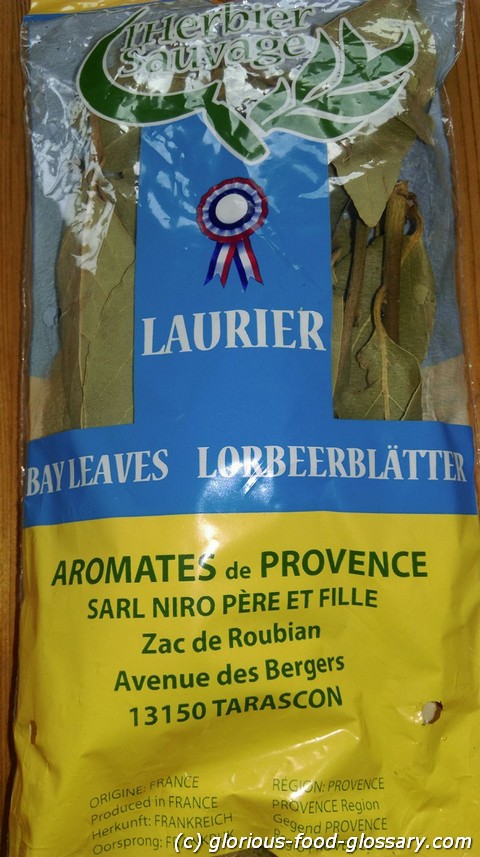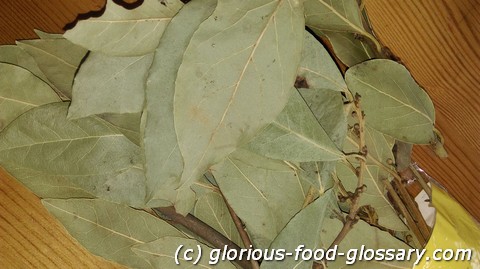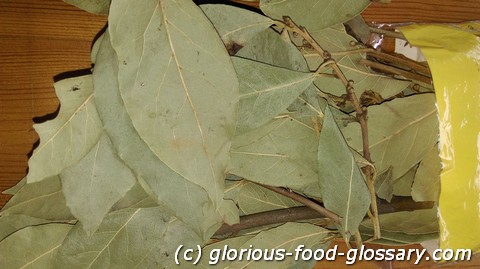Deutsch: Lorbeerblätter / Español: Hojas de laurel / Português: Folhas de louro / Français: Feuilles de laurier / Italiano: Foglie di alloro
Laurel Leaves in the food context refer to the leaves of the bay laurel tree (Laurus nobilis), used as an aromatic herb in cooking. These leaves are known for their distinctive fragrance and slightly bitter flavor, which can enhance the taste of various dishes. Laurel leaves are commonly used in soups, stews, marinades, and sauces, imparting depth and complexity to the flavors of the dish.
Description
Laurel leaves are typically used whole and are often removed from the dish before serving. They can be used fresh but are more commonly found dried, which concentrates their flavor. The leaves are not meant to be eaten and are used solely for their aromatic qualities. Their presence in a dish is usually subtle but adds a layer of flavor that complements other ingredients well.
Application Areas
Laurel Leaves are used in a wide range of culinary applications, including:
- Soups and Stews: Added to broths and stews for a subtle depth of flavor.
- Marinades: Used in marinades for meat, poultry, and fish to impart aromatic qualities.
- Slow-cooked Dishes: Ideal for long-cooking dishes like braises and pot roasts, where their flavor can infuse the food over time.
- Pickling: Included in pickling solutions for vegetables and fruits.
Well-Known Examples
Some well-known dishes that utilize Laurel Leaves include:
- Beef Bourguignon: A French stew that often includes laurel leaves among its bouquet garni.
- Italian Tomato Sauce: Many Italian tomato-based sauces use laurel leaves to enhance flavor.
- Adobo: A popular Filipino dish that often includes laurel leaves as part of its seasoning.
Recipes
Incorporating Laurel Leaves into a recipe is straightforward:
-
Preparation:
- For soups, stews, or sauces, simply add 1 or 2 dried laurel leaves to the pot as it cooks.
- For marinades, add crushed or whole laurel leaves to the mixture and let the food marinate according to the recipe.
-
Cooking:
- Allow the dish to simmer or cook as required. The longer the laurel leaves simmer in the dish, the more flavor they will impart.
- Remember to remove the laurel leaves before serving, as they can be sharp and are not intended to be eaten.
Treatment and Risks
Laurel leaves are safe for most people when used in cooking. However, it is essential to use true bay laurel (Laurus nobilis) leaves, as some other plants with similar names or appearances can be toxic if consumed. Always source laurel leaves from a reputable supplier to ensure they are safe for culinary use.
Similar Terms or Synonyms
- Bay Leaves
- Bay Laurel Leaves
Summary
Laurel Leaves are a staple herb in various cuisines worldwide, valued for their ability to add a subtle yet distinct flavor to a wide array of dishes. Whether used in soups, stews, marinades, or sauces, laurel leaves are an essential ingredient for any chef looking to create rich and aromatic culinary creations.
--




Related Articles to the term 'Laurel Leaves' | |
| 'Season' | ■■■■■■■■■ |
| Season: In the food context, "season" refers to the process of adding flavor to food by using herbs, . . . Read More | |
| 'Rice' at environment-database.eu | ■■■■■■■■ |
| Rice is one of the most important staple crops in the world, feeding billions of people, particularly . . . Read More | |
| 'Sorrel' | ■■■■■■■■ |
| Sorrel refers to a leafy vegetables /herb which is both known to be edible and medicinal. Sorrels have . . . Read More | |
| 'Inji' | ■■■■■■■ |
| Inji, commonly known as ginger, is a versatile and widely used spice and herb in the culinary world. . . . Read More | |
| 'Cane Vinegar' | ■■■■■■■ |
| Cane Vinegar is a type/variety of vinegar that is made from sugarcane and has a rich, slightly sweet . . . Read More | |
| 'Puerco' | ■■■■■■■ |
| Puerco refers to pork, the culinary name for meat derived from domestic pigs (Sus scrofa domesticus). . . . Read More | |
| 'Flour' at top500.de | ■■■■■■■ |
| Flour in the industrial and industry context refers to the product obtained by milling and grinding cereal . . . Read More | |
| 'Essence' at top500.de | ■■■■■■■ |
| Essence in the industrial context typically refers to a concentrated form of a substance which captures . . . Read More | |
| 'Aioli' | ■■■■■■ |
| Aioli is a French sauce made by mixing lemon, eggs, garlic, and olive oil into a smooth, creamy mixture . . . Read More | |
| 'A la dijonnaise' | ■■■■■■ |
| A la dijonnaise: a la dijonnaise is the French term which means served in a mustard sauce. . . . Read More | |
